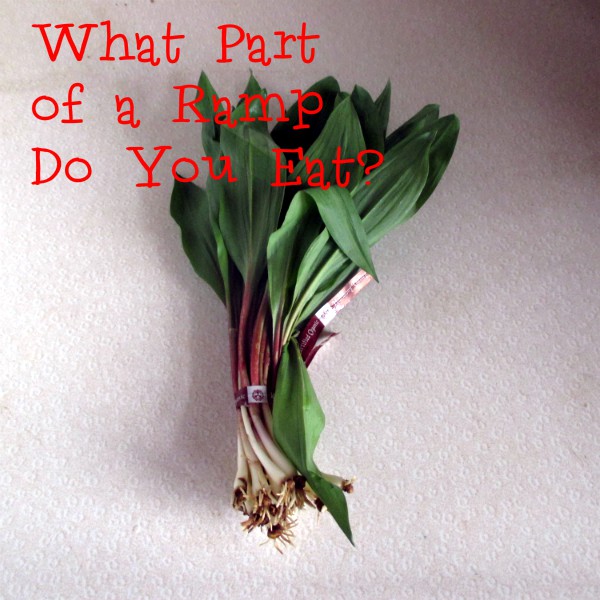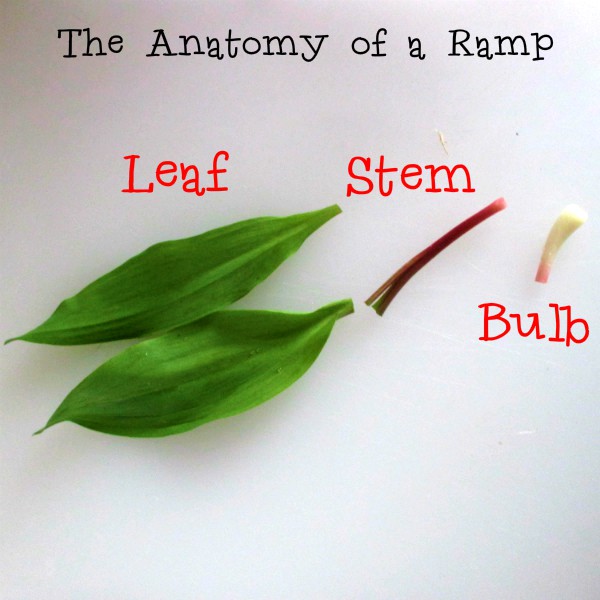Learn what parts of a ramp you are able to eat and what are the best uses for each part of this spring time vegetable.
This post includes affiliate links. This means that, at no additional cost to you, I will earn a commission if you click through and make a purchase. These are products and services I recommend because I use or trust them. Cookies will be used to track the affiliate links you click.
It's the time of year again.
The time of year where foragers are foaming at the mouth, searching the forest for spring's early bounty.
What are they looking for? The morel mushroom, the Fiddlehead fern, and the topic of today's conversation - the ramp or wild leek.
You may find it just as much of a search to find these items in your grocery store. Only more specialty stores like Whole Foods Market (I bought an organic bunch there for $2.99 a bunch) and local small produce shops will carry these products.
If you can find ramps you are in for a treat. Not quite onion, not quite garlic, but flavors of each that come bundled in a unique package. They only grow wild and are harvested at the beginning of spring.
That brings us to the question for today - what part of the ramp is edible? First, let's take an anatomy lesson.
🌱 Parts of a Ramp
As you see in the lovely diagram above, I have divided the ramp into three parts:
- The leaf
- The stem,
- The bulb.
All three of these parts can be used and I do my best to utilize them all. No need to waste what can flavor your food.
🧄 The Bulb
This is what most people are going to use. It kind of looks like a really, really small onion.
The end of these things are full of little roots that trap dirt, so I cut off the roots as close to the end of the bulbs as possible. These roots are only part of the ramp I discard. Then I dice them up like I would garlic. Sauté them just as you would garlic.
I tossed them in at the beginning of a Ramp/Asparagus risotto dish I made last night. You can pickle them as well. Pickled ramps are really good on burgers.
You don't necessarily need to cook the bulbs. Ramps can be eaten raw like you would green onions.
🏆 Best Use - Anything that you use fresh garlic for.
🌿 The Leaf
If you are lucky you will get a nice bunch of bright green leaves with a red vein down the middle. These are completely edible. Although you will wat to use them up first, as they will go bad before the bulbs do.
I like to use the ramp leaves like an herb. I rolled them up, like a carpet. Then slice them into ribbons or what fancy chefs call a chiffonade.
I add the leaves at the end of cooking. Like when I making the previously mentioned risotto, I threw them in at the last minute, just to heat them through.
You could also just throw them in a pan with some butter and cook them until they wilt and eat them like you would spinach, chard, or kale.
Or you can make pesto from the leaves (toss in the bulbs too). When you got ramps, you can really ramp up the possibilities!
🏆 Best Use - Use them like you would an herb in a dish where you want some garlic-like flavor.
When ramps are out of season, you can buy Dried Ramp Leaves from Burlap & Barrel.
🌹 The Stems
This is where the most waste happens. The stems between the leaves and the bulb can be a little tough, a little fibrous.
You can cook ramps whole and eat them just fine. Here is my preference. Cut off the leaves and bulbs. I then take the stems and throw them in the freezer along with my other veggie scraps for the next time I want to make homemade vegetable broth.
When I made that risotto I included roasted asparagus (if you aren't in a risotto mode after this post, you must hate rice!) and save the ends I cut off the asparagus.
I will make my Asparagus End soup with them soon, and include the ramp stems. Won't that really ramp up the flavor! (I know I did the twice in one post, but ramps are only available for a short time, so I only have a few chances).
🏆 Best Use - As part of a homemade vegetable broth.
📅 How Long Do They Last
Fresh ramps will last about 3-4 days in the fridge for the leaves and then probably another 3-4 days for the bulbs. The best way to store them is wrapped in a damp paper towel inside of a plastic zip top bag.
So jump aboard the spring time veggie bandwagon and find yourself some ramps or wild leeks if you prefer. They are a wonderful way to start getting excited about another year full of fresh and tasty produce.
Share with us your ramp experience in the comment section below. I would love to hear from you.




Brittany Davidson
Thank you for your useful information on ramps. I had no idea what they were. I'm currently writing an article on Spring Soups for FoodQuestions.net and will link to this article for support. Hopefully, you send some support my way in return, but either way, thank you!